As one of the most expensive assets your company will likely purchase, a fleet vehicle (or many of them) is a big investment. Likewise, you want to get the best value possible up front while still getting the right car, truck, or van for the job at hand.

Here are some helpful tips that can guide you through the process and ensure you and your company are getting the best deal.
1. Consider all of your options in spec’ing vehicles
When deciding what parameters and features your fleet vehicle must have, try not to eliminate viable alternatives. Consider the scope of what the car or truck will be used for, what options are necessary and where there might be some breathing room.
Unless they are absolutely necessary, make a concerted effort to avoid making any brand or manufacturer-specific specs. Simply put - having an open mind is the key to getting a great deal.
2. Work directly with fleet sales representatives
This may sound like a no-brainer, but there is a distinctive difference between a typical sales department and that which solely focuses on fleet vehicles. Those in fleet sales tend to be more straightforward and no-nonsense. Their job is to move volume, so they work with smaller margins and usually handle financing directly.
Skip the hassle and deal with the people who are ready to sell vehicles to you at wholesale prices.
3. Drive all your options first
Before talking pricing, you should visit nearby dealerships and test out all of the vehicles that are on your potential list. Get the shopping part of the way, so you can get down to business later.
During the test drive process, take good notes, because if you test drive multiple vehicles, they might all run together. Put yourself in the shoes of the drivers that will be using these vehicles day in and day out. Will they be comfortable, safe, etc. and be able to perform their jobs effectively?
4. Check around for the best pricing
Once your list is complete and the vehicles are ranked accordingly, it is time to hit the phones or jump online for quotes. Don’t be afraid of going outside of your area or region to see what kind of pricing you can get. Let the fleet sales rep know exactly what you want and see what they can do, and don’t let the invoice price deter you from asking for a better deal.
Dealerships can get hundreds of thousands, or even millions of dollars, in volume bonuses, so their invoice price might not always be the best representation of costs. Knowing a vehicle’s MSRP is the best way to stay informed from the get go.
5. Know what incentives and discounts are available
As you might imagine, quantity has a lot to do with available discounts. This isn’t the whole story, however. Preferred pricing, as it’s known, is open in many cases to business owners who purchase or lease as few as five vehicles.
Each manufacturer also sets their own required quantity for fleet purchasing. General Motors requires businesses to buy or lease five or more new vehicles in a 12-month period. Toyota asks that a company operate or plan to operate 10 or more, but those 10 can be a mix of vehicles from different manufacturers. Honda’s fleet sales have no quantity restrictions.
Be sure to weigh your options and figure out what option will work best in your procurement strategy.
Need more advice on adding vehicles to your fleet? We’ve got a great guide on creating a rock-solid procurement plan. Download it for free today!
Editor’s note: This blog post was originally posted in June 2013 and has been updated for accuracy and relevancy.



